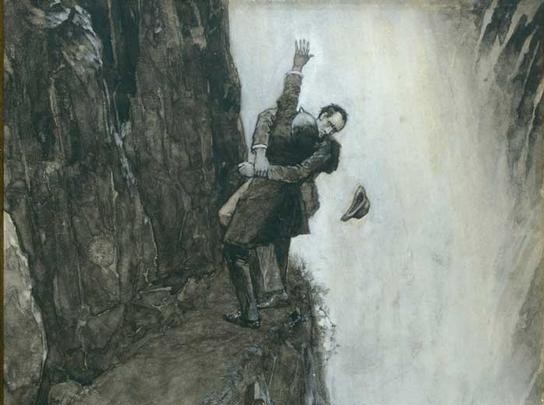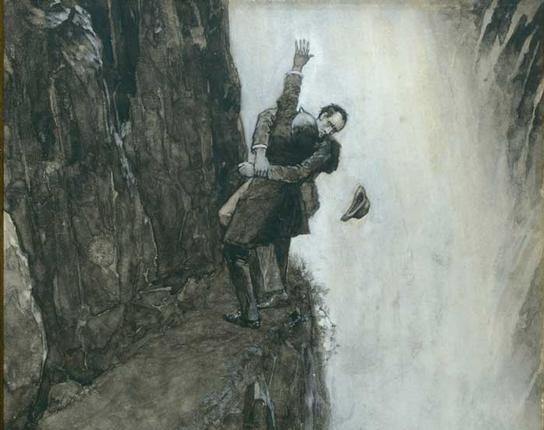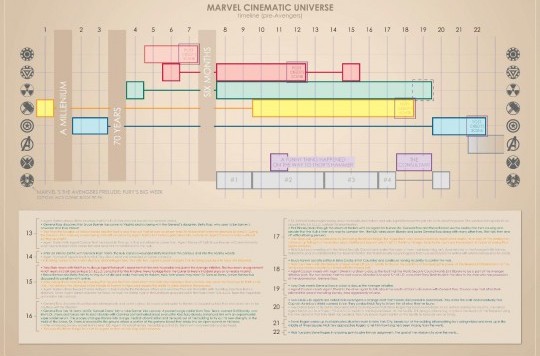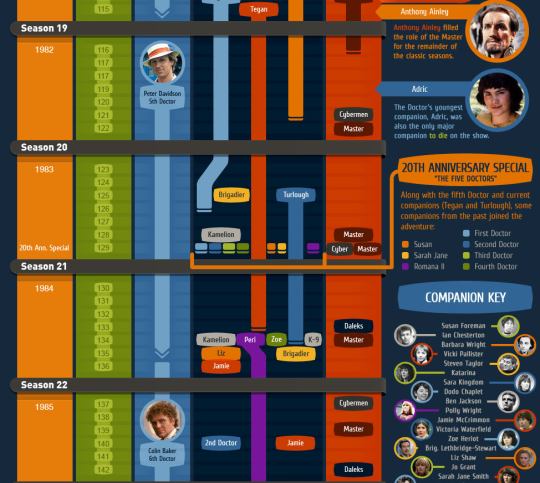Q: How do you keep an idiot in suspense?
A: I’ll tell you part of the answer for sixty minutes each week for the next six years.
FRY: Clever things make people feel stupid, and unexpected things make them feel scared.
Futurama, “When Aliens Attack”
The First Final Problem
Sherlock Holmes is the defining case of the problem of continuity. Conan Doyle killed off Holmes because he was sick of the character, then was faced with the problem of bringing him back. It wasn’t such a terrible problem, even if the solution was a little tacky. Because the stories were written by a fallible first-person observer in the form of Watson, he simply had the smarter character sneeringly assert the unreliability of the narrative:
In your picturesque account of the matter, which I read with great interest some months later, you assert that the wall was sheer. That was not literally true. A few small footholds presented themselves, and there was some indication of a ledge…A mistake would have been fatal. More than once, as tufts of grass came out in my hand or my foot slipped in the wet notches of the rock, I thought that I was gone. But I struggled upward, and at last I reached a ledge several feet deep and covered with soft green moss, where I could lie unseen, in the most perfect comfort. There I was stretched, when you, my dear Watson, and all your following were investigating in the most sympathetic and inefficient manner the circumstances of my death.
Arthur Conan Doyle, “The Adventure of the Empty House”
Hence the problem of continuity: the need for a post hoc coherence to a storyline that was never planned out in the first place.
Because of the nature of mystery fans, Conan Doyle scholarship embraces the eccentric tendency of trying to justify all discontinuities that Conan Doyle never did bother to explain:
The most curious facet of this undeniably sumptuous package lies in Klinger’s decision to play the parlour game of Sherlockian scholarship. Initiated in 1911 by a Catholic priest who intended it as a spoof of scriptural exegesis, the game assumes that Sherlock Holmes actually existed, that the stories really were written by John Watson MD, and that Doyle acted only as the doctor’s agent. The supposed fun lies in ensuring that the canon’s numerous mistakes, implausibilities and inconsistencies are coherently explained away, no matter how tortured the logic required. Klinger fills page after page with the kind of wilfully pedantic literary mischief-making which John Sutherland has turned into an art form. How many wives had Doctor Watson? Did Holmes love the only woman ever to have outwitted him? What colour was the Baker Street dressing gown? And what really happened at the Reichenbach Falls? The whimsy of this conceit swiftly becomes grating and, in relegating the author to the role of mere go-between and front man, also seems faintly insulting to Doyle himself.
Jon Barnes, “Too Spirited for the Spooks,” TLS 07 January 2005
I’m fascinated by the seemingly futile efforts of fans to render coherent what was never intended to be such. In effect, they are rationalizing God’s ways to man.
When John Sutherland does it in books like Is Heathcliff a Murderer? Puzzles in Nineteenth-century Fiction or Who Betrays Elizabeth Bennet?, he does so with a wink and a nod, but the method is essentially the same, postulating clues in order to obtain solutions that aren’t there. Seeing Sutherland ply his craft is instructive because he applies it to works that don’t normally entertain it. He does so in the same spirit as well, coming out of an obsessive love for the world creation of Victorian novelists. Compared to Joyce or Proust, Victorian worlds never felt particularly real to me and so I have little desire to make them more real.
I am, however, easier on the fans than Barnes is. The rationale this “supposed fun” is that it in fact fun of a deep and meaningful variety, and rather than an insult to the author, it is a gesture of fanatical love for characters now elevated to the level of myth. This form of myth, unlike traditional myth, tolerates inconsistencies only inasmuch as they can be explained after the fact, giving it a strangely paradoxical character.
The results, like the results of theodicy, are almost inevitably disappointing, since the absence of a grand plan makes it impossible that such a plan will be discovered. The attribution of too great a level of reality puts both the fans and the creators in a tight spot. The near-inevitable failure of grand unifying moments occurs because the arbitrary restrictions make impossible any satisfactory unification of ex post facto continuity.
Stan Lee’s Shared Rhizomes
Stan Lee was probably not the first to consciously commoditize continuity, but I believe he was the first to achieve massive success through it. The Marvel comics that were written by Lee and drawn by Jack Kirby have far more value for their visual artistry than their plot, but the plot sold the art at least as much as the other way around.
In the 1960s, Lee’s titles fostered fan involvement by printing fan addresses in the letters columns, so that the more involved fans could contact one another. (I thought that Lee invented this gambit, but it turns out to have been originated by DC’s Julius Schwartz. See this excellent Wikipedia article.) But more significantly for our purposes here, Lee loaded up stories with cross-references to previous issues and other titles, putting asterisks in dialogue balloons that pointed to footnotes reading “As seen in Fantastic Four #42! -Ed.” (Lee did not invent this device either, but he put it to far more work.)
Lee, far more than anyone before him, created a tight network of “hyperlinked” content that, naturally, encouraged fans to make sure they bought every single issue of every title, so as not to miss out on part of the continuity. This has come to be known as a “shared universe,” but this term is something of an insult to genuinely fleshed-out universes. It is a network of gaps and contradictions claiming the illusion of coherence. At least call it a “shared rhizome” or something like that.
Yet the embrace of continuity worked, and fans bought into a concept that inherently guaranteed disappointment. The claim of writers like Lee to possess the hidden gnosis of the entire “universe,” to be revealed in dribs and drabs, went mostly unquestioned even when patently false, even when acknowledged to be false.
So one can only attribute fan dissatisfaction to real cognitive dissonance, as here:
One such tool is retconning, short for “retroactive continuity”, where later adjustments result in the invalidation of previously-written material. The most severe form of retcon involves a wholesale rewrite of the groundwork for the entire setting. These reboots, most closely associated with DC Comics, are not always effective at resolving underlying problems and may meet with a negative reaction from fans.
This in turn fosters an attitude of contempt from many writers, who see themselves as absurdly boxed in and know that there is no way to please the fans. In effect, the reaction is: “How can you hold our titles to their false promises of coherence when those promises were so blatantly ridiculous?” You can see the dynamic on display as Lost scribe Damien Lindelof squirms under interrogation from Josh Horowitz, half-embarrassed and half-condescending. Hence Fry’s quote at the beginning of this essay. (Lindelof had acted in especially bad faith by earlier claiming that the show had been planned out from the start.)
Doctoring the Doctor
When fans become part of the creative apparatus, this contempt becomes internalized, and the simultaneous effort to worship continuity while knowing it is a lie can come to resemble the internal workings of religious bureaucracies.
The posts at the Tardis Eruditorum hypothesize a particularly nasty form of this self-immolation occurring in the 1980s with Doctor Who, which became both nastier and more incoherent as it incorporated fandom and fan feedback into its creative process, under the diabolical show-runner John Nathan-Turner.
There, in the context of discussing the killing off of a character no one liked anyway, Philip Sandifer writes, “The problem is that so much of fandom seems unaware of the ‘guilty’ part of guilty pleasures.” I think it’s more epistemological than that, at least for the more fanatical of fans. It’s a matter of cognitive dissonance. The pleasure of buying into a world of continuity, and the suspense of having it revealed slowly, requires an ongoing suspension of disbelief that is impossible to sustain in the face of growing evidence that nothing is in fact being revealed.
Doctor Who, sheerly by dint of being on continuously for longer than any other such continuity-based program short of a soap opera (where large-scale continuity isn’t an issue since characters can simply be abandoned), probably faced this problem first, a point which I’m grateful to Sandifer for pointing out. That the results were frankly disastrous bears repeating. Sandifer puts the logic succinctly in talking about the 1983 twentieth (!) anniversary special The Five Doctors, in which the five actors to have played the part to that point (one a ringer for a dead actor, another appearing only through leftover old footage) had to be worked into a single story:
On the one hand, Nathan-Turner is obsessed with strip-mining the program’s history. On the other, Nathan-Turner remains obsessed with distinguishing himself and glorifying his tenure as producer. And so the program is increasingly obsessed with referencing its past for the sole purpose of trying to show how much better it is than the very past that it sees itself as primarily existing to reference.
Terence Dicks has said that his strategy in writing The Five Doctors was to just put everything in and trust that nobody was going to look too hard at the glue. This is, again, essentially correct. The story proceeds not according to narrative logic but according to a paratextual logic. It is driven by a need to shove in every signifier of Doctor Who it can find, and more to the point, its audience knows it. It works not according to plot logic but according to the logic of nostalgia.
The Dalek is the point where this is most blatantly signposted. It appears, gets one scene, and is abandoned, having served its purpose. The audience, upon seeing this, knows exactly what sort of story this is.
Not all of the audience. For a substantial number of fans, frequently the most vocal ones, the story remains one more set of jigsaw pieces to assemble into a puzzle that does not in fact fit together. And so continuity purposes and creative purposes become an ever-more-quickly-spinning ourobouros.
This intolerable self-loathing seems to have resulted in what Sandifer terms the nadir of the series, “The Twin Dilemma,” a rewriting of the Doctor mythos so horrendous as to be indefensible. I will let Sandifer, whose sense of betrayal is palpable, tell it, since his passion conveys more of the sheer hatred at the heart of the story than a rote plot summary would:
Colin Baker’s Doctor isn’t just unlikable here. He’s intolerable. He’s an overtly bad person who any reasonable audience should actively dislike and want to see get his comeuppance. Whereas the series still visibly thinks he’s the hero. It’s not just that Baker’s Doctor is prickly and hard to like, it’s that he’s a bad guy.
…The Doctor attempts to choke his heavily sexualized female companion. He physically and violently assaults her in a manner that is chillingly familiar as a real-world phenomenon that happens to women at the hands of their male partners. Then he drags her against her will to what he says could be an entire life in which “it shall be your humble privilege to minister unto my needs.” She readily forgives him and grins stupidly at his charms. It’s not Nicola Bryant’s fault – she plays the material as well as it can be played. Nor is it Baker’s fault. They try to make the scenes watchable, but nobody could possibly make this work. Peri is violently assaulted by a man who overtly sees her only purpose as being to serve him, and chooses happily to stay with him. The show treats this man as its hero and expects the audience to tune in nine months later to watch his continuing adventures.
Of course they declined to. Baker’s Doctor is completely poisoned here. There’s nothing whatsoever that can be done to make this character watchable to anyone who has seen this. And I speak from experience here. This is the story that killed my parents’ interest in Doctor Who. To this day my mother refuses to accept the possibility that Baker might be good on the audios simply because of how much this story made her hate him. That’s how bad this played to people. That’s how you kill Doctor Who in under a hundred minutes. You make it about a battered woman idolizing her abuser.
Yeah, OK. I take it back. This is the worst fucking story ever.
Tommy Westphal’s Head
These days the embrace of continuity is done with simultaneous irony and fanaticism, sort of a post-Nietzschean “God is dead but can we pretend he’s alive?” approach. It’s prima facie absurd to try to figure out all the television characters who were only in Tommy Westphal’s mind on St. Elsewhere by tracing crossovers, but then again, someone did it. There doesn’t even need to be the stated intent of continuity to practice this game.
This is ultimately because the problem of continuity is unavoidable. As long as you are recycling the same characters or other pieces of a creative franchise, there has to be some addressing, even unintentionally, of the relation of this particular version to other versions. There is only one actual explanation, which is that the decisions are made pragmatically and haphazardly on a case by case basis with more or less respect for the past. The best writers simply pick and choose the bits that work best for them, weaving a particular version into the fabric.
But the shared, commoditized myth of continuity mandates that the appeal of such work be in its continuity linkages, and so there is a tension between the big picture fandom appeal and any desire to make art. This is analogous to the more general trend of genre-conformity vs. individual artistic achievement, played out in the more restricted context of actual characters and plot rather than in the context of mere archetypes. Instead of “revenge tragedies” or “knight-errant novels,” we get “Dragonlance novels” or “Star Trek movies.” Such franchises become their own sub-genres.
Assorted sleights-of-hand have been established: the dreaded reboot is the one in common parlance, while alternate universes remain a semantically more acceptable method of changing established rules arbitrarily. Ignoring or finessing continuity will only result in fans trying to solve the problems themselves, as with Sherlock Holmes. Foisting this work off onto fans is probably the best approach anyway, so as to free the writers from plotting and character constraints that make crap art almost inevitable, but creators can’t be seen to say this explicitly, so instead it is sublimated into contempt for their audience. The altar of continuity is a shrine to a false god.




